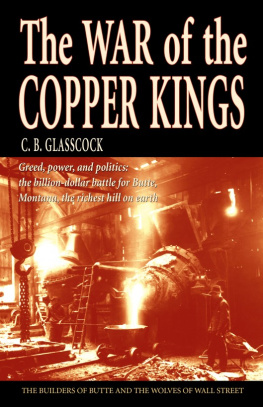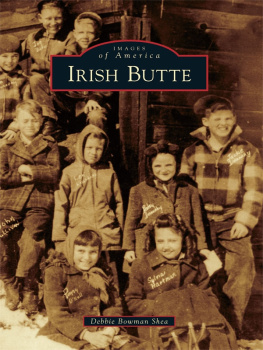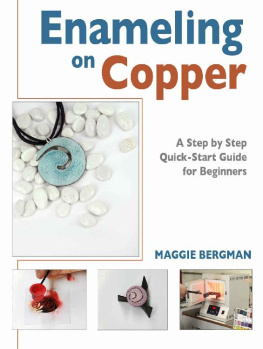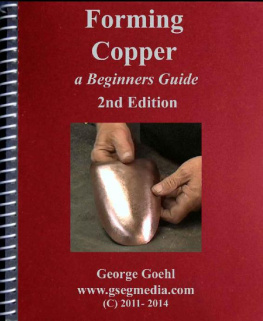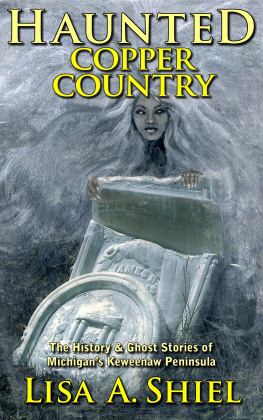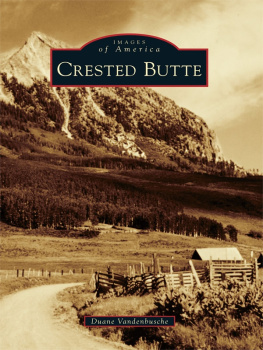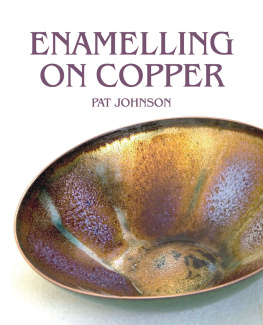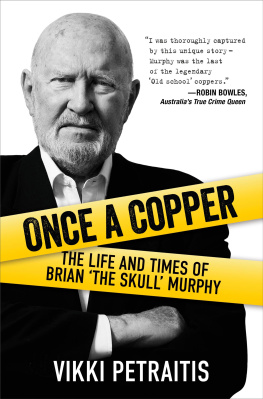The War of the Copper Kings
Greed, power, and politics: the billion-dollarbattle for Butte, Montana, the richest hill on earth
By C.B. Glasscock
Smashwords Edition
E-Book ISBN: 978-1-60639-054-2
Copyright 1935 by C.B. Glasscock
Copyright 1962 by Marion T. Glasscock
Original elements of the Riverbend edition copyright2002 by Riverbend Publishing.
All rights reserved.
This ebook is licensed for your personal enjoymentonly. This ebook may not be re-sold or given away to other people.If you would like to share this book with another person, pleasepurchase an additional copy for each recipient. If youre readingthis book and did not purchase it, or it was not purchased for youruse only, then please return to Smashwords.com and purchase yourown copy. Thank you for respecting the hard work of this author andpublisher.
This book is available in a printed edition.
Cover design by DD Dowden
Riverbend Publishing
P.O. Box 5833
Helena, MT 59604
1-866-787-2363
www.riverbendpublishing.com
To
The Old Dealers
In sympathy with their errors, and admiration oftheir accomplishments
Acknowledgements
For the material facts and expressions ofvaried personal opinion contained in this narrative the authoracknowledges his indebtedness to many persons and printed sources.First among them, perhaps, should be named the Historical Societyof Montana at Helena, Mr. David Hilger, librarian, and his veryable and courteous assistant, Mrs. Anne McDonnell. They opened toresearch the files of scores of Montana newspapers of the decadefrom 1895 to 1905 which are quoted in the text.
Men and women who contributed generously inpersonal interviews number scores. Of those who took prominentparts in the great drama and who told the writer of theirexperiences and reactions, the principals included John J.McHatton, a judge in Butte for many years, and one of F. AugustusHeinzes leading attorneys; William Scallon, long the residentdirector of the Amalgamated Copper Companys war against Heinze inButte; Charles R. Leonard, Heinzes personal counsel in the finalsettlement with the Amalgamated; Lee Mantle, once United StatesSenator from Montana and a prominent citizen, mine owner andpublisher in Butte for many successful years; John Gillie, for halfa century a mining engineer in Montana, for many years chiefengineer of the Amalgamated, personal friend of Marcus Daly, and atthe time of this writing still consulting engineer of the AnacondaCopper Mining Company. John MacGinniss, Heinzes right hand man inmuch of the action, asserted that if the men named had told theirstories, nothing more was needed to complete the picture.
Completion however was sought in interviewsand other assistance generously given by James W. Scott, veterannewspaper reporter who covered the Pennsylvania vs. Rarus suit in1899 and many others of the scores of historic legal actions; MissHorgan, Miss Sternfels and Miss OMeara of the Butte PublicLibrary; Samuel Barker and Arthur V. Corry, mining engineers; JudgeGeorge M. Bourquin, Judge W. I. Lippincott, D. J. Charles, Mrs. T.J. Murray, Jerry Clifford and various residents and pioneers ofButte in all walks of life who helped to reveal the varied life ofthe town as well as the economic and political drama. Alex Leggatgave free access to his private library with its superiorcollection of Montaniana. Lew. L. Callaway, Chief Justice of theSupreme Court of Montana, and noted authority on the early historyof the territory, contributed generously of material on thevigilante days.
Outside of these sources, former residents ofButte now living in other cities were equally kind and helpful.Those interviewed included Mrs. E. B. Weirick, president of theMontana Womans Club of Southern California; Charles Henderson,once sheriff of Silver Bow County; Ben E. Stack, whose memories ofButte date back to 1876; Lee Hayes, mining engineer of Butte as farback as 1897; Dr. W. L. Renick; Will L. Clark, Clerk of theDistrict Court in 1888, and later employed at various times byMarcus Daly, William A. Clark and F. A. Heinze; Charles T. Shearer,an active newspaper man of the early days; Judge Sydney Sanner,Mrs. Nell
A. DeLeon, and others. Mrs. Isaac Edingerintroduced the writer to numerous productive sources of material.Ike Edinger contributed from his memories of more than fiftyyears as rancher, bank director and public-spirited citizen ofMontana.
The W. A. Clark Memorial Library in LosAngeles, under the direction of Miss Cora E. Sanders, opened itsfiles and stacks to free research.
Printed sources of information, in additionto the Montana newspaper files, include various magazines whichrecognized the drama twenty-odd years ago as a matter of nationalinterest and moment: Everybodys, McClures, Current Literature,Donahoes, Leslies, Engineering & Mining Journal,Cosmopolitan.
Books which have afforded both facts andsidelights on the period and activities involved include Thomas W.Lawsons
Frenzied Finance, Ridgway-Thayer Co.,1905; Jerre C. Murphys The Comical History of Montana, E.L. Scofield, 1912; Tom Stouts Montana, American HistoricalSociety, 1921; Helen F. Sanders History of Montana, LewisPublishing Co., 1913; George Wesley Davis Sketches ofButte, The Cornhill Co., 1921; Dictionary of AmericanBiography; U. S. Senate Reports, 56th Congress, 1stsession, 1899-1900; T. J. Dimsdales Vigilantes of Montana,1866; Hoffman Birneys Vigilantes, Penn Publishing Co., 1929.
The extent and variety of the sourcesacknowledged should be emphasized because of the highlycontroversial nature of the subject. The violence of the warfarewas demonstrated most vividly in the course of research by the factthat numerous persons interviewed still maintained an intensepartisanship a third of a century after the action. For that reasonthe names and comments of some of the old-timers may open oldwounds and stir indignation anew, but at the same time should beconvincing evidence that an honest effort has been made to narratenothing more than essential facts and opinions. Those who feel thattheir own particular hero has not been revealed in the mostfavorable light can only be referred to the names and standing ofwitnesses for the opposition.
C. B. GLASSCOCK
Chapter I
Civilization at Scratch
A group of ragged, bearded, weary men, fleeing fromhostile Indians, made camp beside an alder-lined creek high in theRocky Mountains in the spring of 1863. One washed two dollars andforty cents worth of gold from a panful of sand. Unsuspected inthat sand was the promise of one hundred million dollars in goldapromise soon to be realized.
Latent in the surrounding ground were themakings of more than one hundred murders, more than a score ofhangings without process of law, more than two billion dollars inmaterial wealth, a corporation designed to rule the electric lightand power of the world, battles of giants in the depths of theearth and in the capital of the nation, and a financial panic thatstaggered the country in 1907.
Bill Fairweather and his associates were ontheir way to the town of Bannack, the first rich gold camp in allthe vast region of the northern Rockies, opened only the yearbefore by John White. They had been prospecting around theheadwaters of Yellowstone River, and had escaped with their scalpsonly because Fairweather, six feet two of bone and sinew, with amustache long enough to loop behind his ears, and a red beardhalfway to his gun belt, had bluffed the Sioux medicine men to astandstill. There is a legend still accepted in Alder Gulch and bysome students of the early history that Bill sustained that bluffby juggling two writhing, hissing, striking rattlesnakes before theshrinking noses of the Injuns.

